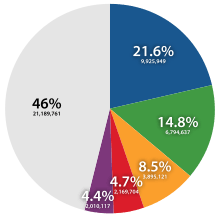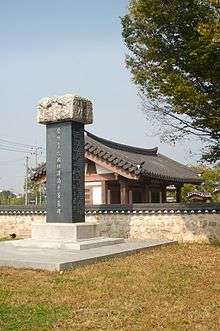Lee (Korean surname)
| Lee | |
|---|---|
|
The one of hanja for Yi | |
| Pronunciation | [iː] or [riː] |
| Language(s) | Korean |
| Origin | |
| Language(s) | Chinese |
| Word/Name | Korean peninsula |
| Meaning |
|
| Other names | |
| Variant(s) | I, Yi, Ri, Rhee, Rhie |
| See also | Li, Lý |
| Families | |
| Deoksu clan, Jinseong clan, Yong-in clan, Gyeongju clan, Yeoju clan, Jeonju clan, Danyang clan, Yangsan clan, Suan clan, Seongjoo clan, Hongju clan, Yeonan clan | |
| Yi (Ri) | |
| Hangul | 이 (리) |
|---|---|
| Hanja | 李, 異, 伊 |
| Revised Romanization | I (Ri) |
| McCune–Reischauer |
Yi (Ri) Note: North Korean usage for only "李" is in parentheses, also between North and South usage for "異" and "伊" is only out of parentheses |

Lee is the typical romanization of the common South Korean surname I (Hangul 이), North Korean surname Ri (리). The name is written identically to the Chinese name Li 李 in Hanja characters. It is the second-most-common surname in Korea, behind only Kim.
Pronunciation and Latin-alphabet spelling
Though the official Revised Romanization spelling of this surname is I, South Korea's National Institute of the Korean Language noted in 2001 that one-letter surnames were quite rare in English and other foreign languages and could cause difficulties when traveling abroad. However, the NIKL still hoped to promote systemic transcriptions for use in passports, and thus recommended that people who bore this surname should spell it Yi in the Roman alphabet.[1][2]
The overwhelming majority of South Koreans with this surname ignored this recommendation and continue to spell it as Lee. In a study based on 2007 application data for South Korean passports, it was found that 98.5% of people with this surname spelled it in Latin letters as Lee in their passports, while only 1.0% spelled it Yi.[3]
A few people with this surname historically spelled it Ye, as in Ye Wanyong of the Korean Empire. Rhee has also been used as the Latin letters as in Syngman Rhee and Simon Hang-bock Rhee
Clans

As with all Korean family names, the holders of the Yi surname are divided into different patrilineal clans, or lineages, known in Korean as bon-gwan, based on their ancestral seat. Most such clans trace their lineage back to a specific founder, and are generally not related to one another. This system was at its height under the yangban aristocracy of the Joseon Dynasty, but it remains in use today. There are approximately 241 such clans claimed by South Koreans. Most people with surname Yi (李) in Korea belong to either the Jeonju or Gyeongju clans. Also surname Yi (異) and Yi (伊) each have a different clans.
Imperial Household of the Jeonju Family

This clan has direct imperial roots to the founding of the Joseon Dynasty. The founder of this clan was Yi Han, a native of Baekje who later married a Silla princess and became a high official of Silla. His 22nd-generation descendant, Taejo of Joseon, went on to found the Joseon Dynasty. The House of Yi ruled Joseon for 518 years between 1392 and 1910, and established many of the cultural, artistic and linguistic foundations for modern-day Korea.
During its reign, the House of Yi consolidated its effective rule over the territory of current Korea, encouraged the entrenchment of Korean Confucian ideals and doctrines in Korean society, imported and adapted Chinese culture, and saw the height of classical Korean culture, trade, science, literature, and technology. The House of Yi has left a substantial legacy to modern Korea; much of modern Korean etiquette, cultural norms, societal attitudes towards current issues, and the modern Korean language and its dialects derive from the culture and traditions of their ruling period.
As of 2014, the pretender to the Korean throne was Haewon, Princess of Korea. Members of the different branches of Jeonju Yi family dominated Korean history until the formation of the current Republic of Korea. Many families claim membership in the House of Yi, but few actually descend from the royal lineage. The House of Yi, in conjunction to its royal status, has produced innumerable figures of extraordinary influences in politics, the sciences, the arts, finance and academia. Many of these descendants play key roles in world politics, the sciences, the arts, finances, and academia today. Notable descendants include South Korea's first president Syngman Rhee; the inventor of the modern Korean alphabet, hangul, and renowned polymath King Sejong the Great; the founder of the Joseon dynasty, as well as modern Korea, King Taejo; among many others.
Gyeongju clan
The founder of this clan was Alpyeong, one of the original village headmen of Silla, who chose Bak Hyeokgeose as the first king. According to the Samguk Sagi, the Yi name was officially bestowed on the family by King Yuri around 9 CE.
Notable present-day members of this clan include: Lee Byung-chull, the founder of Samsung Group; Lee Kun-hee, the former Samsung CEO; and Lee Myung-bak, former president of South Korea.[4]
The Gyeongju Yi clan, according to the 2000 South Korean census, numbered over 1.4 million individuals, making it the most numerous of the clans that bear the surname Yi.[5]
Pyeongchang clan
The founder of this clan was Yi Gwang, an official of the Goryeo period. Yi Seung-Hun, who was the first person that brought Catholicism to Korea, was in Pyeongchang clan. Yi Seung- Hun descendant Namgang Lee Seung- Hun(1864-1930) was one of the most important figures in helping Korea gain its independence from Japan. Namgang Lee Seung- Hun was also one of the most financially successful people during his time. In his forties, Seunghun Lee devoted himself to social work and tried to support talented young people by founding the Kangmyung uisook and the Osan School. He participated in the New People’s Association (Shinminhui), and became a Christian in 1910.Seunghun Lee was sentenced to 10 years in 1911 due to ‘105 Persons Incident’ (a resistance movement by Korean patriots). In 1931, he was again sentenced to 3 years because he was one of the thirty three national representatives for the March 1st Independence Movement. Due to Seunghun Lee’s connection with the Independence Movement, the Osan School and other churches Seunghun Lee founded were burned by the authorities, and all of the teachers at Osan were arrested. When Seunghun Lee was released under probation from prison in 1922, he founded “Jamyeon Association” in Yongdong and donated 0.8 acre of land for co-op farming. Lee also established the Chosun Education Association with Sang-Jae Lee and Jin-Tae Yoo, and continued his education business with Osan School as its center. In 1930, his last request before he died was to donate his corpus for educational purposes, but his last wish was not fulfilled due to interference from the Japanese imperial authorities. In 1962, he received posthumously the order of merit for his national foundation.
Deoksu clan
The founder of this clan was Yi Dongsu, an official of the Goryeo period. This was a prominent yangban clan during the Joseon Dynasty, producing figures including the admiral Yi Sun-sin and the philosopher Yi I. The clan seat, Deoksu, corresponds to Deoksu-hyeon, an old division of what is now Kaep'ung-gun in Kaesong city, North Korea.
Jinseong clan
Jinseong Yi clan was known for the famous Joseon scholar Yi Hwang who founded the Yeongnam school and started a private Confucian academy. He also became one of the 18 Sages of Korea (동방 18현) and was honored as a Munmyo Bae-hyang (문묘배향).[6] The progenitor of this clan was Yi Seok from the Goryeo Dynasty.
Yong-in clan
The founder of Yongin clan was Yi Gil-gwon who helped to found Goryeo.
Yeoju clan
Prominent members of this clan include the Joseon Dynasty philosopher Yi Ik.
Danyang clan
The founder of this clan was Jeong Dojeon, who was the first Prime Minister of Joseon and had close relations to King Yi Seonggye. He bestowed upon him the right to start his clan, a right only a yangban could ask, thus Jeong Dojeon created a new yangban clan. The clan's ancestral seat is Danyang.
Yangsan clan
The founder of this clan was Yi Man-yeong, an internal minister in Korea following the fall of the Goryeo Dynasty. He died of strangulation near an isolated mountain.
Suan clan
The founder of this clan was Yi Gyeon-ung, who helped found the Goryeo Dynasty.
Seongju clan
The founder of this clan was Yi Sun-yu, a prominent official of late Silla. His 12th-generation descendant Yi Jang-gyeong was also a prominent official of the Goryeo Dynasty. Eight generations of Jang Kyung's descendants yielded 75 civil examination qualifiers. As of a 2000 census conducted by the ROK, 186,188 Koreans of the Seongjoo Yi clan live in South Korea.
Hongju clan
The founder of the Hongju Yi clan was Yi Yu-seong, a member of the King's inner circle during the late Goryeo Dynasty. The clan's ancestral seat was bestowed when his 9th generation descendant, Yi Gi-jong, was titled. Hongyang/Hongju is located in present-day Hongseong, South Chungcheong Province. Especially during the late Goryeo and early Joseon Dynasties, the Hongju Yi clan produced many outstanding and influential people, including Yi Yeon-su, Yi Seong, Yi Seo, and Yi Jong-jang.
Yeonan clan
Yeonan Yi clan[7] was an aristocratic family clan during the Joseon Dynasty. They had several members become prime ministers and were known to have one of the highest numbers of Chief Scholars during that period. The progenitor was Yi Mu who was from Tang China.
People with the surname
See also
References
- ↑ 성씨 로마자 표기 방안: 마련을 위한 토론회 [Plan for romanisation of surnames: a preparatory discussion]. National Institute of the Korean Language. 25 June 2009. p. 8. Retrieved 22 October 2015.
- ↑ Kim, Yun-gu (2009-06-25). "성씨 로마자 표기 朴 'Bak' 李 'Yi' 제시" [Rules of romanization for surnames: 'Bak' for 朴, 'Yi' for 李 proposed]. Yonhap News. Retrieved 2015-03-07.
- ↑ NIKL 2009, p. 59
- ↑ Han Jeong-gon (한정곤) (2004-07-29) <재벌가 얽히고 설킨 혼맥 24탄> 삼성그룹 Ilyo Siisa, Vol. 445
- ↑ Surname Info. "I." (Korean language site - "이" is spelled phonetically as "I") The specific reference is at the very bottom of the main entry, under the section "[인구 (人口) - 경주, 월성]," which gives both the 1985 census population of the clan at 1,217,279 individuals, and the 2000 population at 1,424,866 individuals. http://www.surname.info/i/gyeong_ju.html
- ↑ Joseon Annals, September 15, 1604. No. 4
- ↑ Joseon Annals, March 21, 1790. No. 3
.svg.png)